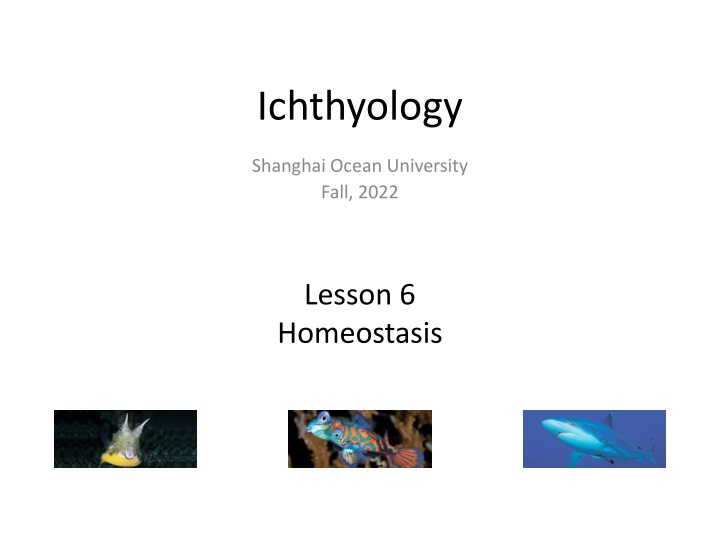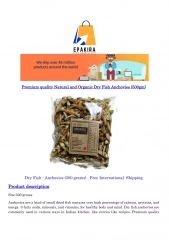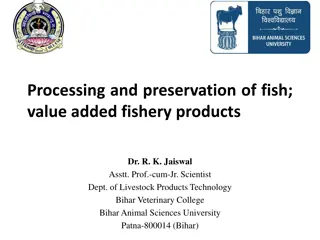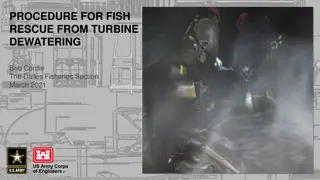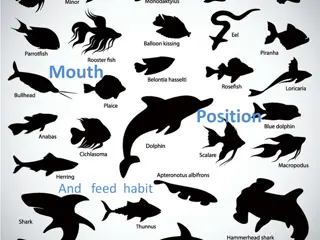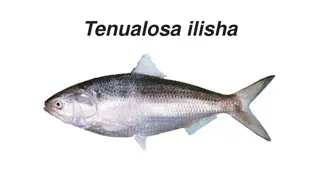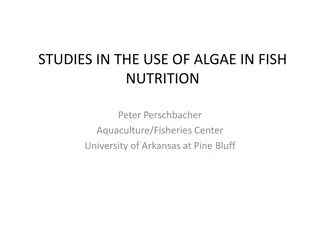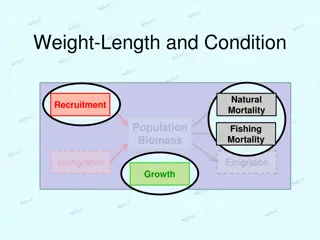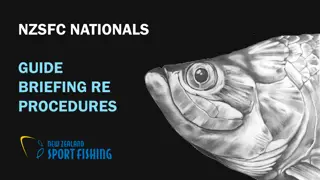Fish Homeostasis: Lesson 6 Insights
Fish homeostasis involves excretion, pH balance, hormones, and the immune system. Explore the role of gills, kidneys, hormones like prolactin and cortisol, and how fish maintain internal equilibrium. Understand innate and adaptive immune responses and the impact of stress on fish physiology.
Download Presentation

Please find below an Image/Link to download the presentation.
The content on the website is provided AS IS for your information and personal use only. It may not be sold, licensed, or shared on other websites without obtaining consent from the author.If you encounter any issues during the download, it is possible that the publisher has removed the file from their server.
You are allowed to download the files provided on this website for personal or commercial use, subject to the condition that they are used lawfully. All files are the property of their respective owners.
The content on the website is provided AS IS for your information and personal use only. It may not be sold, licensed, or shared on other websites without obtaining consent from the author.
E N D
Presentation Transcript
Ichthyology Shanghai Ocean University Fall, 2022 Lesson 6 Homeostasis
excretion, ion and pH balance Gills are an important osmoregulatory and excretory organ for fishes. Their large surface area, thin membranes, and highly specialized cell types make them well suited for this role. Nitrogen wastes are eliminated in the form of ammonia (NH3) and its cation ammonium (NH4+), both of which are soluble in the surrounding water. Diffusion of these wastes across the gills does, however, require immersion in water. Fishes that can survive out of water for extended periods convert ammonia to urea, which is less toxic and can be stored until the fish returns to the water. The kidneys also play an important role in osmoregulation and excretion. The basic process of urine formation in most fishes is similar to that of other vertebrates.
Hormone involved Prolactin appears to play a large role in adaptation to fresh water by decreasing the permeability of gill, kidney, bladder, and intestinal membranes to water and stimulating the uptake of sodium and chloride by the mitochondria-rich cells of the gills. Cortisol, a stress hormone, apparently assists with sodium and chloride uptake by freshwater fishes, and C-type natriuretic peptides seem to help with sodium uptake and retention in hypoosmotic environments. Cortisol also plays an important role in saltwater adaptation, by increasing the size and number of mitochondria-rich cells reducing levels of sodium and chloride in the blood and modifying the lining of the intestine to increase water absorption
pH balance Blood pH is largely affected by metabolic byproducts such as carbon dioxide, which forms carbonic acid when in solution, and organic acids such as lactic acid from anaerobic metabolism. Fishes instead rely on epithelial transport of ions that affect pH, such as hydrogen ions and bicarbonate ions, and the primary responsibility for this seems to fall on mitochondria-rich cells that typically are found in the gills
The immune system The immune system plays an important role in homeostasis by maintaining animal health in both innate and adaptive ways
Stress In a broad context, stress can be considered as a biological response that drives physiological systems outside their normal range. Physiological responses to stress typically occur in three phases. The primary response is mainly the immediate release of epinephrine, followed by the release of cortisol in teleosts or 1a-hydroxycorticosterone in elasmobranchs. The release of cortisol and the reaction to it, however, begin more slowly and are sustained for a longer period of time. Together, these hormones activate biochemical pathways that lead to the secondary phase of the stress response, which is marked by elevated levels of blood glucose to support an increased metabolism. In addition to elevated blood glucose, the secondary response also is characterized by increased respiration rate, increased blood flow to the gills, and increased gill permeability
Stress Another part of the secondary response occurs at the cellular level the induction of stress proteins. These are often called heat shock proteins (HSPs) because they were initially described as a response to elevated temperatures. However, they are now recognized as a general cellular level response to many types of stress, including temperature, various types of pollution, handling, hypoxia, and pathogens. There are three general categories of stress proteins, based on their molecular weight, and they seem to help maintain the function of other proteins If stress persists, the primary and secondary responses may lead to tertiary responses at the whole-animal or population level. Persistent elevated levels of the stress hormones, especially cortisol, can negatively affect fish growth, condition factor (length3/ mass), reproduction, and behavior such as swimming stamina because energy that would have been available for these functions has been diverted to dealing with stress
Summary Most long-term regulation of physiological processes in fishes is accomplished by the endocrine system. Many endocrine tissues are controlled by the pituitary, which is controlled by the hypothalamus of the brain. Physiological functions controlled by the endocrine system include osmoregulation, growth, metabolism, color changes, development and metamorphosis, and stress responses. Some environmental contaminants can disrupt hormonally regulated physiological functions, such as sexual differentiation, because their structure mimics that of naturally occurring hormones. Involuntary physiological functions, such as heart rate, blood pressure, blood flow to the gills and gas bladder, and the contraction of the smooth muscles of the gut, are controlled by the autonomic nervous system.
Summary Most fishes have body temperatures close to that of the water around them because of heat exchange at the gills. Some large pelagic predators, such as tunas and lamnid sharks, can maintain elevated body temperatures by conserving the heat generated in the active swimming muscles through countercurrent heat exchange. Billfishes use heat from special thermogenic tissue behind the eye to keep their eyes and brain warm while swimming in deep, cool water. Seasonal changes in water temperature affect fish metabolism. Fishes can compensate for some change by altering the concentration or form of certain enzymes to maintain essential biochemical processes in cold conditions.
Summary High water temperatures diminish the availability of oxygen in the water and can destroy physiologically important proteins such as hemoglobin and many enzymes. Hence, few fishes can survive warm water temperatures. The temperature of sea water in polar regions drops below the freezing point of the blood of most fishes. To avoid freezing, many polar fishes rely on supercooling or biological antifreeze compounds.
Summary The large surface area of the highly permeable gill membrane allows for considerable exchange of water and ions between a fish s blood and the surrounding water. To maintain a fairly stable internal osmotic condition, freshwater bony fishes produce dilute urine and take up ions through mitochondria-rich cells in the gills. Saltwater bony fishes must drink sea water to replace water lost by diffusion, and they also must eliminate excess ions through their kidneys and the mitochondria-rich cells of the gill epithelium. Elasmobranchs gain water by diffusion due to high levels of urea and TMAO in their blood.
Summary Osmoregulation in fishes is controlled by several hormones, including urotensins, cortisol, prolactin, and the catecholamines (epinephrine and norepinephrine). Most fishes eliminate nitrogenous wastes at their gills in the form of ammonia or ammonium. Fishes also produce urea, which is excreted in the urine. Kidney structure in fishes does not permit the concentration of urine to exceed the concentration of the blood plasma.
Summary A fish s immune system acts to prevent the entry of pathogens, or to destroy them if they do enter the body. The proper functioning of this system can be compromised by stress, such as that caused by handling or environmental factors including certain contaminants.
HWK Homework 6.docx due on Oct 30 No late hand-in will be graded Read Chapter 7
Presentation for next week (Oct 30) Summarize all sensory systems in sharks Describe different types of reproduction features (postfertilization development and embryonic nutrition) in sharks, and give examples for each type Introduce lungfishes (speciation, morphological and physiological difference, adaptation, evolution history, etc.) Provide an introduction of the Chinese paddlefish
Presentation for next week Sent me your ppt+voice or video on Saturday (Nov 14). Talk for 7 min
The term paper Hand in your introduction and list of references by midnight tonight Sent it to me by email, chli@shou.edu.cn The draft of the term paper is due on Dec 11
Pomfret () Yin et al., 2019, Molecular systematics of Pampus (Perciformes: Stromateidae) based on thousands of nuclear loci using target-gene enrichment
